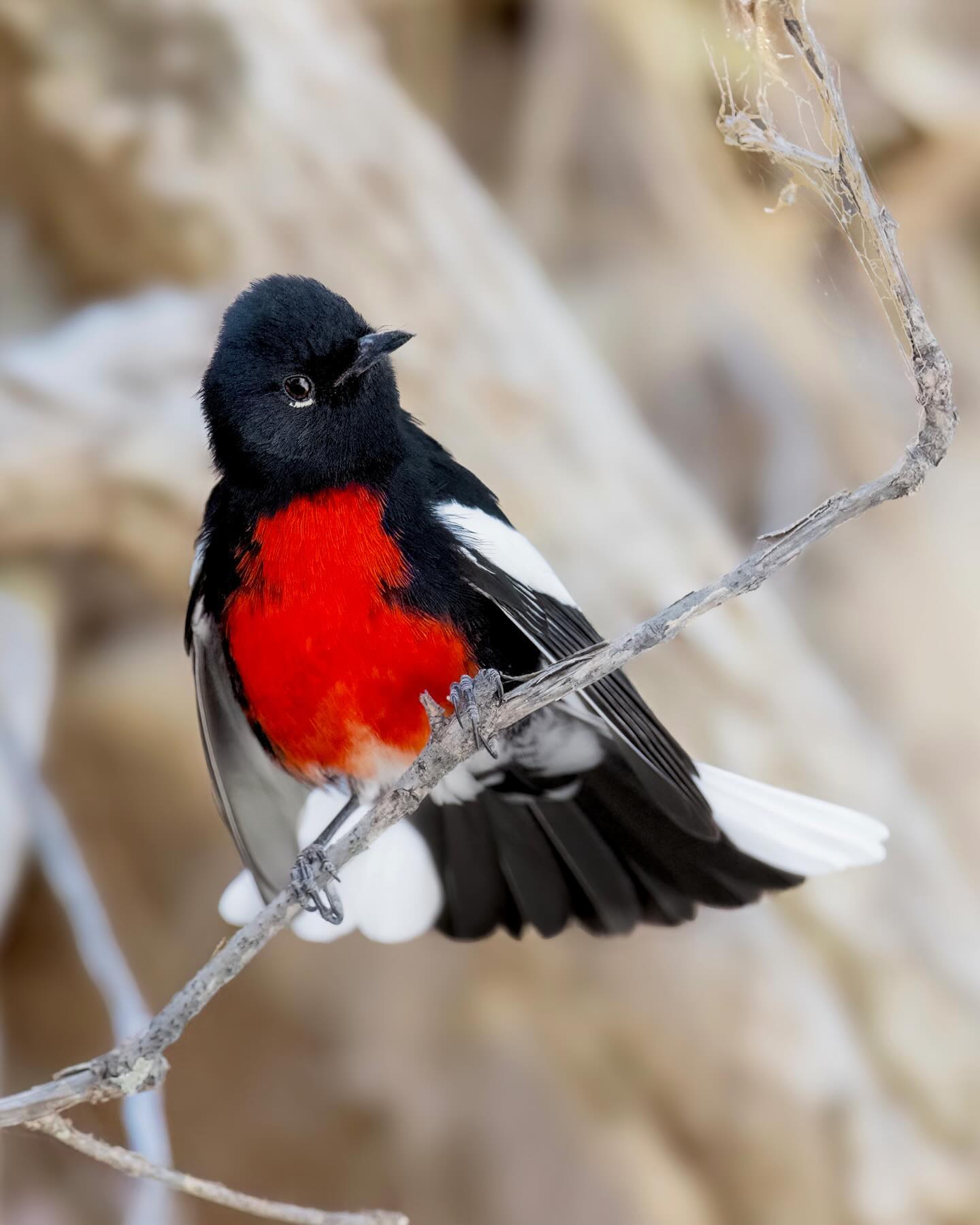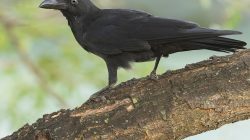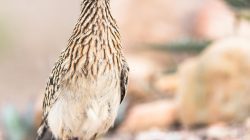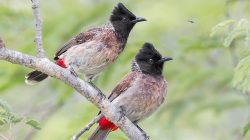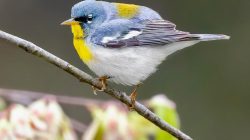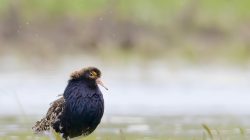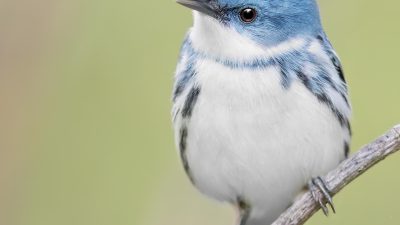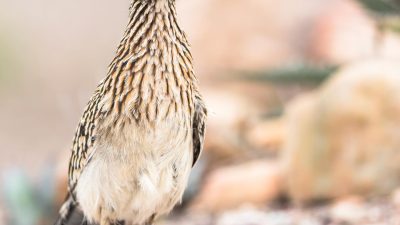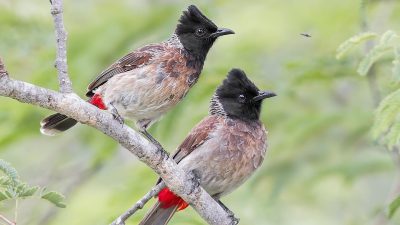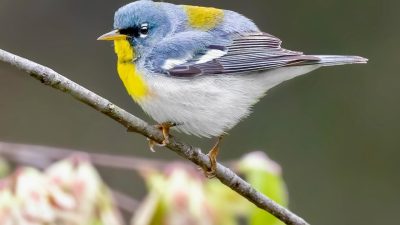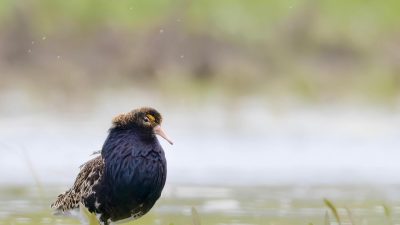The Painted Redstart (Myioborus pictus): An In-Depth Study of a Beautiful Avian Species
Diajar.net – The Painted Redstart (Myioborus pictus) is a striking and colorful songbird found in parts of North and Central America. With its brilliant plumage and energetic movements, it has captivated birdwatchers, ornithologists, and nature enthusiasts alike. Known for its vivid red, white, and black feathers, the Painted Redstart is a species that brings a burst of color to the forests it inhabits. In this article, we will explore the origin of its name, its appearance, distribution, geography, habits and lifestyle, diet and nutrition, population, number of populations, and its conservation status.
1. Origin of Animal Name
The scientific name of the Painted Redstart, Myioborus pictus, provides clues to the bird’s distinctive characteristics and its place within the avian world. The genus name, Myioborus, comes from the Greek words “myia,” meaning fly, and “boros,” meaning glutton, referring to the bird’s feeding behavior, specifically its habit of catching flying insects. The species name, pictus, is derived from the Latin word for “painted” or “decorated,” a fitting description of its colorful and patterned plumage.
The common name, Painted Redstart, reflects the bird’s striking coloration, with the word “start” being an older term for birds in the warbler family. The “redstart” name is often associated with brightly colored birds, particularly those with a red-colored tail or other parts of their body, which is certainly true for this species.
In the Americas, it is also known by other regional names such as Redstart Warbler due to its resemblance to other warbler species, although it belongs to the family Parulidae rather than the true warblers in the genus Setophaga.
2. Appearance
The Painted Redstart is a small songbird, measuring about 13 cm (5 inches) in length. Despite its size, it is highly noticeable due to its striking and vibrant plumage. The male and female Painted Redstart have similar characteristics, but the males tend to have slightly brighter and more vivid colors.
Male Painted Redstart
The male Painted Redstart is a visual delight, with dark black feathers on its head, back, and wings. Its most distinguishing feature is its bright red breast and underparts, which extend to the belly and under the tail. The tail feathers are also vibrantly red, adding a dramatic contrast to the bird’s black wings and back. The wings themselves are edged with white, which enhances the overall visual contrast. This combination of colors gives the bird a striking, painted appearance, making it stand out in its forest habitat.
Female Painted Redstart
The female Painted Redstart is similar in appearance but generally less vibrant than the male. The female has a lighter red wash on its belly and underparts, and the overall red color is often more subdued. The black on the wings, back, and head remains, though not as intensely dark as in males. Both sexes display a unique, white-tipped tail, which they use to signal and communicate with one another.
Overall, the Painted Redstart’s appearance is that of a colorful and energetic bird, easily identifiable by its bold plumage and distinctive movements. It is often found fluttering around in the understory of forests or perched on trees, where it darts between branches in search of insects.
3. Distribution
The Painted Redstart is primarily found in the southern parts of North America, specifically in regions spanning from the southern United States to Central America. It inhabits various temperate and subtropical forests, particularly in mountainous areas where the environment is suitable for the bird’s dietary and nesting needs.
United States
In the United States, the Painted Redstart is primarily found in Arizona, New Mexico, and parts of Texas, especially in highland forests. Its range extends into Mexico, where it is more common. During the summer months, it migrates from its more southern habitats to areas in the Chihuahuan Desert or other mountainous regions that offer more abundant food sources.
Mexico and Central America
The Painted Redstart’s range stretches further south into Mexico, where it is more widespread. It is particularly common in the Sierra Madre Occidental and Sierra Madre del Sur, but it can also be found in parts of the Yucatán Peninsula. In Central America, it can be spotted in countries such as Guatemala and Honduras, though it is most abundant in the higher altitudes of the mountainous regions.
The bird’s migration patterns are somewhat localized, with some populations being year-round residents in their preferred habitats, while others move between higher and lower altitudes depending on the season.
4. Geography
The Painted Redstart thrives in mountainous and forested areas, preferring moist, shaded environments that provide plenty of food and shelter. It is often found in mixed coniferous forests, oak woodlands, and pine forests, particularly those located at higher elevations. These areas provide an ideal habitat with a blend of open spaces and dense foliage, which is crucial for both foraging and nesting.
The Painted Redstart is commonly found at elevations ranging from 1,000 to 3,000 meters (3,280 to 9,840 feet), but it can also be found in lower elevations in the southern parts of its range, particularly in Mexico and Central America.
In addition to these mountainous regions, the Painted Redstart can also be spotted in riparian corridors near streams and rivers. These environments often feature lush vegetation, which attracts the insects the Painted Redstart feeds on.
5. Habits and Lifestyle
The Painted Redstart is an active and agile bird, known for its energetic movements and acrobatic feeding habits. It is a highly territorial species during the breeding season and will aggressively defend its nesting site from other birds.
Foraging Behavior
One of the most distinctive behaviors of the Painted Redstart is its foraging style. The bird is often seen darting and hopping through the forest understory, searching for insects, spiders, and other small invertebrates. It uses a method known as flicking, where it flutters its wings and tail in rapid motions to flush insects from the undergrowth, which it then catches mid-air.
Social Behavior
While often seen alone or in pairs, the Painted Redstart may also form small, loose foraging groups in areas with abundant food. The species is relatively social outside of the breeding season, and these groups can be seen feeding together in the same tree or area. However, during the breeding season, the Painted Redstart is more solitary and focused on defending its nesting territory.
6. Diet and Nutrition
The Painted Redstart’s diet consists mainly of insects and other small invertebrates. It feeds on a variety of creatures, including caterpillars, beetles, ants, and flies, which it catches by flicking its wings and tail to disturb the foliage. This acrobatic feeding behavior is highly effective in its forested habitat, where such insects are abundant.
While the Painted Redstart primarily relies on insects for food, it will also consume fruit and nectar during certain times of the year, especially when insects are less abundant. It is not uncommon to see these birds perched on flowering plants, where they feed on nectar and occasionally small fruit.
7. Population
The Painted Redstart is currently classified as a species of Least Concern by the International Union for Conservation of Nature (IUCN), due to its relatively stable population and wide range across North and Central America. However, certain populations of this bird may be vulnerable to environmental changes such as deforestation, climate change, and habitat degradation.
Population Trends
The Painted Redstart’s population has been relatively stable in recent years, particularly in the United States and Mexico, where its habitat is more abundant. However, the bird’s population in Central America could face challenges, as forest loss and deforestation continue to threaten its preferred habitats.
Ongoing research into the bird’s population dynamics is necessary to monitor changes and ensure that the Painted Redstart does not face significant population declines in the future.
8. Number of Populations
The Painted Redstart is found in several distinct populations across its range. These populations are often grouped by geographic region, with the most notable subpopulations occurring in the southern United States, Mexico, and Central America. The most numerous populations are found in the mountainous regions of Mexico and the southwestern United States, where they thrive in forested habitats.
Although specific population numbers are difficult to pinpoint, it is believed that the Painted Redstart has a relatively large and healthy population across its range. However, habitat fragmentation and climate change could potentially disrupt this balance, making it important to monitor these subpopulations closely.
9. Conservation
While the Painted Redstart is currently not considered a species at high risk, conservation efforts are essential to ensure its continued survival. The main threats to the Painted Redstart’s population include deforestation, habitat degradation, and the effects of climate change.
Efforts to preserve the bird’s habitat focus on the protection of highland forests, which are critical for the bird’s breeding and foraging needs. Additionally, initiatives to combat illegal logging and promote sustainable land-use practices are crucial in preserving the Painted Redstart’s habitat.
Conservationists also advocate for the creation of protected areas and national parks in regions where the bird is most abundant. By preserving these natural spaces, it is possible to ensure that the Painted Redstart has access to its vital forested environments.
Conclusion
The Painted Redstart (Myioborus pictus) is a vibrant and fascinating bird that captures the imagination of birdwatchers and ornithologists alike. With its striking red, white, and black plumage, energetic behavior, and specialized feeding habits, it remains one of the most beautiful and intriguing species in North and Central America. While the Painted Redstart’s population is currently stable, conservation efforts are essential to ensure that future generations of this remarkable bird continue to thrive in its natural habitats. By preserving the forests and ecosystems that support the Painted Redstart, we can help ensure that this stunning species remains a part of our natural world for years to come.
